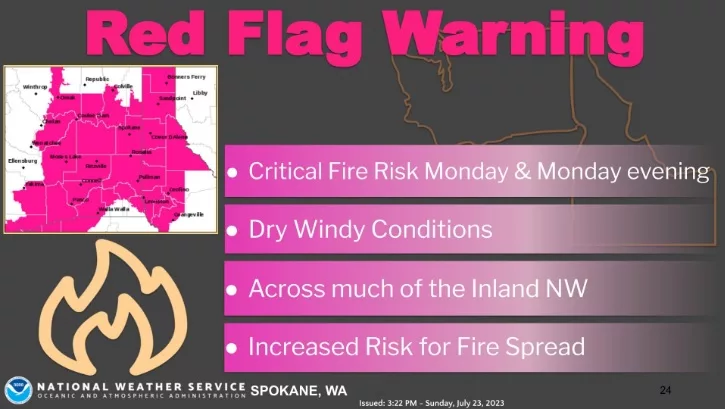
KAMIAH, ID – Hot temperatures and little to no wetting rain over the last four weeks have pushed the region’s fire danger into the Very High to Extreme range as the end of July approaches. The recently issued Fire Weather Watch has been updated to a Red Flag Warning which will be in effect through 11:00 p.m. tonight.
There is still no significant moisture forecasted over the next 7-10 days.
“Hot, dry and breezy conditions are anticipated with winds gusting up to 30 mph in exposed locations. A few thunderstorms are possible (15-20 percent chance) near the Bitterroot Divide Monday afternoon. A cold front will move through the region tonight, which will keep some breezy winds in the terrain into Tuesday morning. Isolated thunderstorms are possible along the front, mainly north of Highway 12. Both live and dead fuels across most of North Central Idaho are beginning to reach a critical threshold where the possibility of large fire growth exists,” according to a press release from the Nez Perce-Clearwater National Forests.
From the NP-CNF:
Fire personnel have been engaged in taking direct holding actions using ground personnel and helicopter water drops on the Clean Slate prescribed fire from this spring. Fire managers state that they expect activity to increase with the predicted weather, so the public can expect to see an increase in firefighting traffic both on the ground and in the air over the Clean Slate Rx project area. A few pockets of dense vegetation totaling approximately 100-150 acres and logging slash have been smoldering since ignitions and are still burning within the confines of the original planned burn perimeter. This is expected with large scale prescribed fires such as Clean Slate and fire managers have been monitoring the fire conditions since ignition in May of this year. Some heat remains in the interior and fire personnel are taking appropriate action. No immediate threats are apparent currently. Salmon River Ranger District Fire Management Officer Josh Bransford stated, “We’ve ordered a couple of crews to go in and help with these holding actions, even though everything is still within the planned prescribed fire area. Under different circumstances, such as a more favorable weather forecast, we would most likely just monitor and let the prescribed fire continue to achieve the objectives of the prescribed fire plan,” Bransford added.
The Clean Slate prescribed fire is a part of the Lower Salmon River Wildfire Crisis Strategy Priority Landscape. All implemented prescribed burning will contribute to the goals of the nation’s Wildfire Crisis Strategy by creating a more resilient and fire-adapted landscape and helping to protect communities in the Wildland Urban Interface from wildfire. The goal of any fuels reduction project is to break up the fuel continuity so that during a wildfire, fire behavior changes and firefighters have more options. The Nez Perce-Clearwater has implemented many of these fuels reduction projects and successfully utilized the resulting fuel breaks during wildfire suppression. The most recent example of this is the Williams Creek fire of 2022 which burned around and over the town of Orogrande. The Orogrande Community Protection fuels reduction project, implemented from 2018 through 2021, included timber harvest and hand thinning, followed by prescribed burning. When the Williams Creek fire ran into the project units, fire behavior was moderated, dropping from the tree canopy to the ground. This allowed firefighters and residents to “herd” the fire around the town preventing loss of property. Adjacent untreated areas experienced much higher severity burning.
Other past examples on the Nez Perce-Clearwater National Forests include the Interface Fuels project which prevented the Woodrat Fire of 2015 from coming into the community of Syringa; the Lowell Wildland Urban Interface project which prevented the Andy’s Hump fire from impacting the Lowell community in 2017; Windy-Shingle project and the Rattlesnake Fire of 2019 which helped to reduce fuels and impacts to many inholdings and private homes that are positioned mid-slope in the Salmon River canyon. These are great examples of the fact that wildfire will still happen regardless of the work done, but that work greatly reduces the overall threat and impacts to life and property.
The most recent and updated information for the Little Bear and Midnight Fires can be found at:

